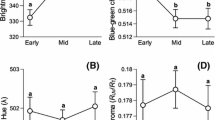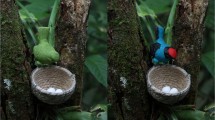Summary
-
1.
African Black Oystercatchers Haematopus moquini select nest sites according to macrohabitat type, local substratum, the presence of plants and other objects at and close to the nest, and shelter. Nest sites in both structurally complex and simple habitats are highly cryptic.
-
2.
Eggs are cryptic and there are consistent differences in the patterns of pigmentation between first and second laid eggs within a clutch but between females of the same population overall clutch pattern is similar and only the intensity of pigmentation varies. Within-clutch differences in egg markings did not result in differential predation rates of first and second eggs, but increases nest complexity and hence the crypticity of the clutch.
-
3.
Nests are usually sited adjacent to feeding territories. When such sites are not available, birds “leapfrog” over the territories of neighboring pairs rather than attempt nesting in marginal habitats, and may nest several hundred metres away from their feeding territories. Eggs of “leapfrogging” birds had the highest survival and hatching rates in the study area.
Similar content being viewed by others
References
Burger J, Shisler J (1980) Colony and nest site selection in Laughing Gulls in response to tidal flooding. Condor 82:251–258
Chamberlin ML (1977) Relationships between egg pigmentation and hatching sequence in the Herring Gull. Auk 94:363–365
Croze H (1970) Searching image in Carrion Crows. Z Tierpsychol (Beiheft) 5:1–86
Hall KRL (1959) Observations on the nest site and nesting behaviour of the Black Oystercatcher Haematopus moquini in the Cape Peninsula. Ostrich 30:143–154
Hartwick EB (1974) Breeding ecology of the Black Oystercatcher Haematopus bachmani. Syesis 7:83–92
Hockey PAR (in press) The distribution, population size, movements and conservation of the African Black Oystercatcher Haematopus moquini. Biol Conserv
Hughes RN (1979) Optimal diets and the energy maximisation premise: the effect of recognition time and learning. Am Nat 113:209–221
Montvecchi WA (1976) Field experiments on the adaptive significance of avian eggshell pigmentation. Behaviour 58:26–39
Montevecchi WA (1978) Nest site selection and its survival value among Laughing Gulls. Behav Ecol Sociobiol 4:143–161
Preston FW (1957) Pigmentation of eggs: variation in the clutch sequence. Auk 74:28–41
Summers RW, Cooper J (1977) The population, ecology and conservation of the Black Oystercatcher Haematopus moquini. Ostrich 48:28–40
Summers RW, Hockey PAR (1980) Breeding biology of the Whitefronted Plover in the southwestern Cape, South Africa. J Nat Hist 14:433–445
Author information
Authors and Affiliations
Rights and permissions
About this article
Cite this article
Hockey, P.A.R. Adaptiveness of nest site selection and egg coloration in the African Black Oystercatcher Haematopus moquini . Behav Ecol Sociobiol 11, 117–123 (1982). https://doi.org/10.1007/BF00300100
Received:
Accepted:
Issue Date:
DOI: https://doi.org/10.1007/BF00300100




